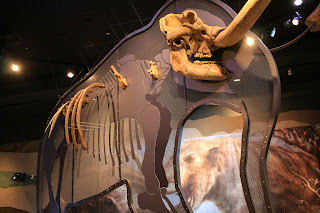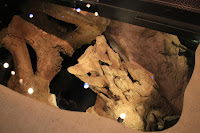I turned 50 last week and for my birthday I wanted to go to natural history museums. I’m a museum nerd, a paleontology nerd, and the Pleistocene is my favorite time period, so I planned a trip to the Los Angeles area. I told my family that they could come but they had to be willing to be dragged to museums and weren’t allowed to complain about it. So I planned a four-day weekend and we saw four museums (plus an aquarium). The museums were the La Brea Tar Pits/George C. Page Museum, the Western Science Center, the San Bernardino County Museum, and the Natural History Museum of Los Angeles County. More on the museums themselves later.
California is a pretty awesome place for paleontology. The state mandates that any paleontological artifacts encountered during construction be reported and dug up by a salvage paleontologist. With all the construction that happens in that state, this means a lot of specimens for science. The finds in the LA area are Pleistocene, so that means lots of megafauna for museums.
I love proboscideans—the elephant family (proboscis = nose). There are a lot of extinct elephant species, besides the two extant species, including four-tuskers, shovel-tuskers, and straight-tuskers. The proboscideans we met in LA were:
At La Brea:
American mastodon (Mammut americanum)
Columbian mammoth (Mammuthus columbi)
Comparison of lower jaws (mandibles) of Columbian mammoth and pygmy mammoth
Pygmy mammoth (Mammuthus exilis) – “exilis” because they were exiled onto small islands off the Californian coast. Island populations are weird because big animals tend to evolve smaller (because of limited resources) while small animals tend to evolve big (because of lack of predators). These wee little mammoths lived on Santa Rosa, San Miguel and Santa Cruz islands up to 10,000 years ago.
 |
| You could keep a pygmy mammoth as a backyard pet! |
At Western Science Center:
Pacific mastodon (Mammut pacificus) – this holotype of a new species is nicknamed “Max.” The Pacific mastodons are larger than the American mastodons, and none have tusks in the lower jaw (many American mastodons do).
Columbian mammoth (Mammuthus columbi) “Xena”
 |
| "Xena" in front, "Max" behind |
I really like how Western Science Center presents its fossils. One of the complaints you hear from science deniers is that “dinosaur bones are all replicas,” implying that they are fake, just made-up fantasies like Godzilla. Yes, most (but not all) mounted skeletons are replica casts; the fiberglass casts are much sturdier and much lighter weight, and leave the actual bone free for study. At Western Science Center, the mastodon and mammoth are mounted with a metal silhouette and casts of the bones put in the anatomical location, and then in the base of the mount under glass are the actual bones themselves, nestled in sand to support the fragile bones. You can see the real bones, with the real glue that preparators used. Max’s pelvis is too fragile to cast, so only the real bones are present under the mount.
 |
| Max's femur. You can see the preparation glue. |
 |
| Max's left ribs |
 |
| Xena's fibula and femur |
At San Bernardino County Museum:
American mastodon (Mammut americanum) – they weren’t actually fluffy but it’s so cute! A fluffy dire wolf threatens the fluffy mastodon from the second floor.

At the Natural History Museum of LA County:
American mastodon (Mammut americanum)













